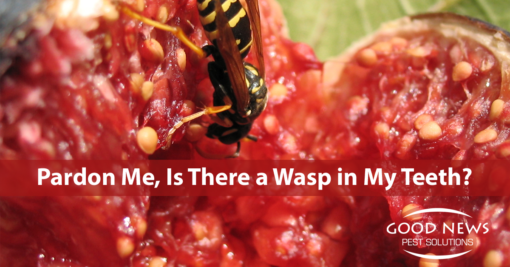
Pardon Me, Is There A Wasp in My Teeth?
Fruits and vegetables all have very interesting textures. And one of the most unique is that of the fig. Fleshy, yet firm, sweet, yet filled with little bits that too often get stuck in your teeth. But don’t worry, unlike the Internet rumors or schoolyard tales, those bits aren’t dead wasps – they’re just seeds. The primary reason for the fig’s unique texture is the way it’s pollinated. You’re surely familiar with the most popular pollinator, our old friend the honeybee. And if you’ve been reading our site regularly, you’ve seen how mosquitoes are the number 2 pollinators. Figs are unique in that there is one single solitary insect that insures their yield continues: fig wasps. Fig Wasps and figs exist in a mutually beneficial, symbiotic relationship. That is, each needs the other to survive. In school, you probably learned that most flowers expose their pollen producing organs: the stamen and the pistil, located in or about the center of the bloom of a flower. Figs are unique in that their “blooms” are inverted. So to get the pollen to its destination, the fig wasp must burrow down into a very narrow passage into the heart of the fig – a passage so narrow, it costs the wasp her wings, antenna, and life. And, just like people, there are two kinds of fig trees – male, which produce inedible caprifigs – and females, which produce the edible figs we buy at the grocery store or farmer’s market. When the wasp enters a male caprifig, she lays her eggs and dies. When the eggs hatch, the male wasps, which are born wingless, dig tunnels out of the fig allowing the newly birthed females to escape and take the pollen they’ve collected to fertilize other figs. However, when the wasp enters the female edible fig, she has no place to lay her eggs, but cannot retreat because of the loss of her wings. Eventually, she dies, and an enzyme inside the fig breaks the wasp down into protein that the fig uses to sustain itself while ripening. So technically, yes, something that used to be a wasp is in your teeth, in the same way that the grass a cow eats is in your hamburger. But the crunchy bits are not wasp parts, but fig seeds. And one last note – while fig wasps are the only pollinators for figs, there are more than 900 species of fig wasps, each designed to pollinate a couple different species of fig trees. That’s a lot of effort for a package of fig newtons! Here at Good News Pest Solutions, we care about the environment and endeavor to use cutting-edge, natural, eco-friendly pest control measures that are safe for our earth and you, while being highly effective at controlling pests. If you are looking for a green pest control company, look no further! You have found the Gulf Coast’s leader in natural pest control; contact us today!
« Back to BlogProudly Serving
Sun City Center, Ruskin, Palmetto, Parrish, Ellenton, Bradenton, Anna Maria, Holmes Beach, Bradenton Beach, Longboat Key, Lakewood Ranch, University Park, Myakka City, Sarasota, Siesta Key, Osprey, Nokomis, Casey Key, Venice, Englewood, North Port, Port Charlotte, Punta Gorda, Arcadia
Things You Can Do
Pay Your Bill Online
Leave Us a Review
Request a Free* Termite Inspection
Stop Mosquito Bites
Get Rid of Rodents
Get a Termite Damage Warranty
Get Pest Control for Your Attic
Get Pest Control for Your Business Request Prayer
Corporate Address
1080 Enterprise Court, Ste A
North Venice, FL 34275
Call Now: (941) 412-9610
Text: (941) 412-9610
Fax: (941) 412-0080
